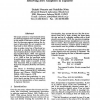Free Online Productivity Tools
i2Speak
i2Symbol
i2OCR
iTex2Img
iWeb2Print
iWeb2Shot
i2Type
iPdf2Split
iPdf2Merge
i2Bopomofo
i2Arabic
i2Style
i2Image
i2PDF
iLatex2Rtf
Sci2ools
90
Voted
EACL
1993
ACL Anthology
1993
ACL Anthology
Resolving Zero Anaphora in Japanese
The paper presents a computational theory for resolving Japanese zero anaphora, based on the notion of discourse segment. We see that the discourse segment reduces the domain of antecedents for zero anaphora and thus leads to their efficient resolution. Also we make crucial use of functional notions such as empathy hierarchy and minimal semantics thesis to resolve reference for zero anaphora [Kuno, 1987]. Our al)proach differs from the Centering analysis [Walker et al., 1990] in that the resolution works by matching one empathy hierarchy against another, which makes it possible to deal with discourses with no explicit topic and those with cataphora [Halliday and Hassan, 1990]. The theory is formalized through the definite clause grammar(DCG) formalism [Pereira and Warren, 1980],[Gazdar and Mellish, 1989; Longacre, 1979]. Finally, we show that graphology i.e., quotation mark, spacing, has an important effect on the interpretation of zero anaphora in Japanese discourse.
Discourse Segment | EACL 1993 | Empathy Hierarchy | Japanese Zero Anaphora | Natural Language Processing |
Related Content
| Added | 02 Nov 2010 |
| Updated | 02 Nov 2010 |
| Type | Conference |
| Year | 1993 |
| Where | EACL |
| Authors | Tadashi Nomoto, Yoshihiko Nitta |
Comments (0)

